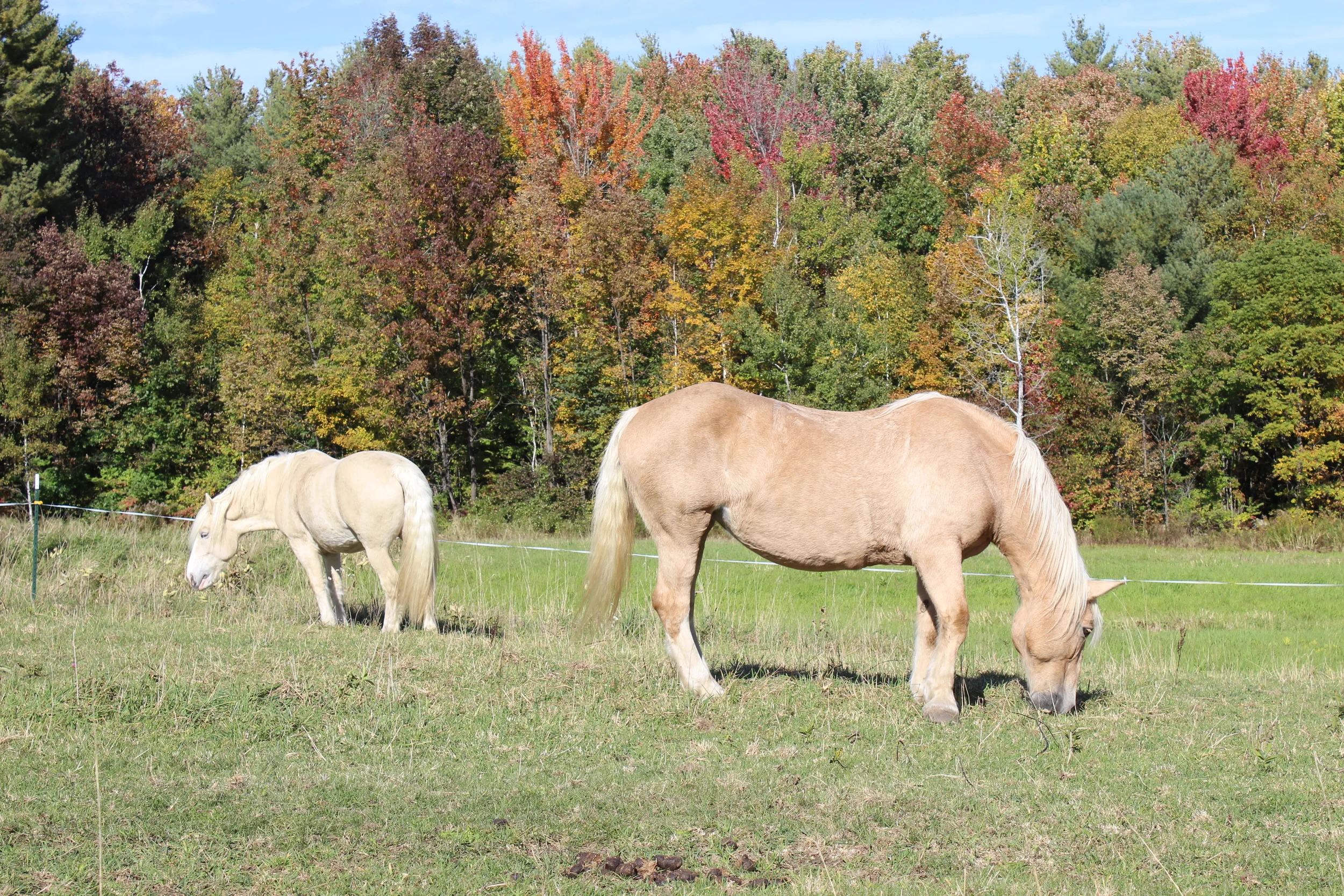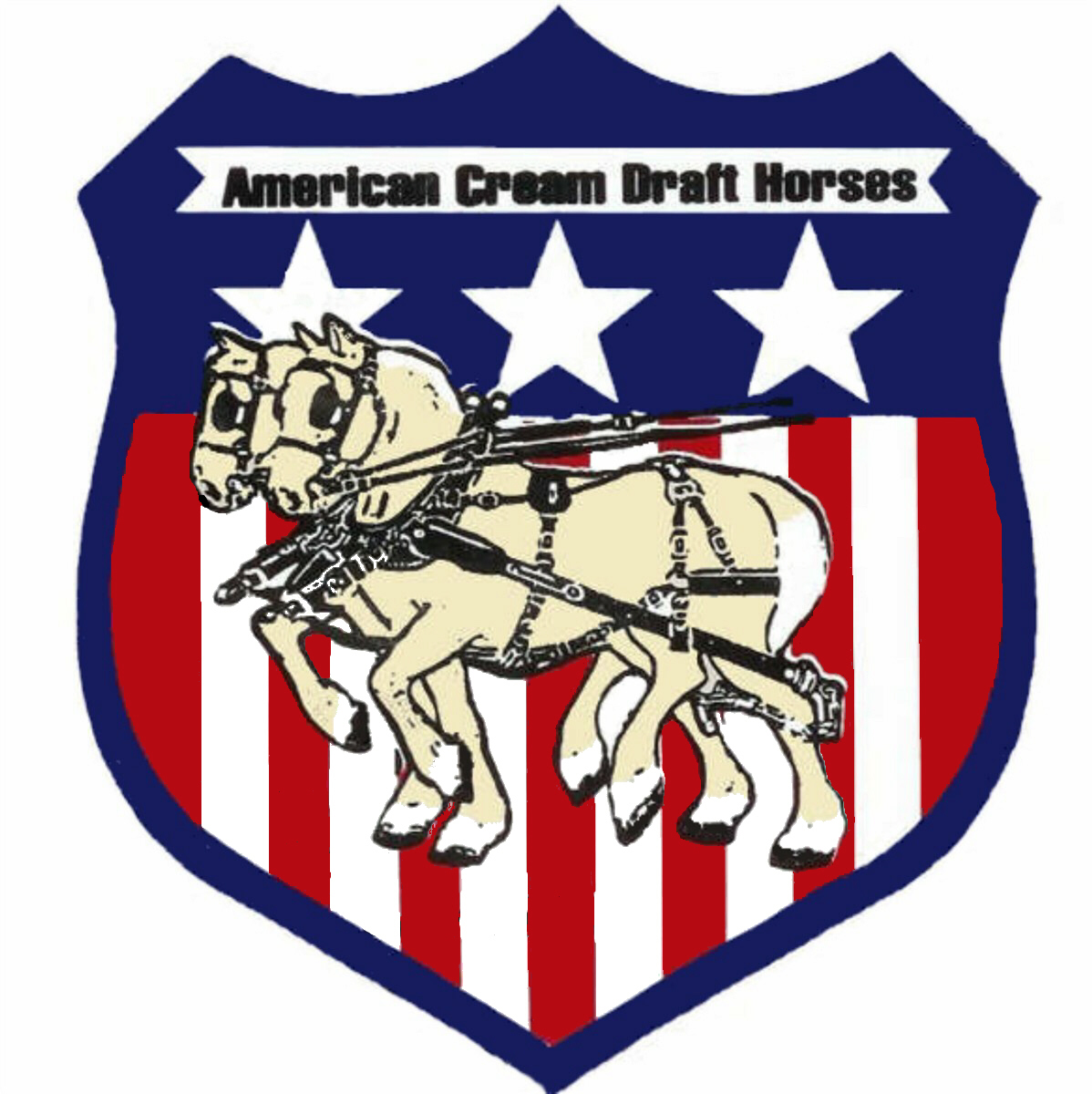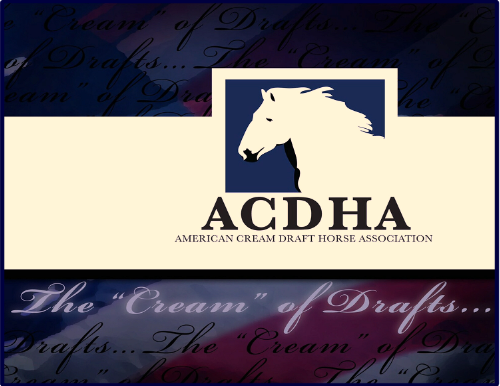The American Cream Draft Horse is the ONLY draft breed that originated in the U.S. from the mare Old Granny beginning around 1905.
This story begins with “Old Granny”, who was a mare of draft breeding who became known as the foundation mare of the American Cream Draft Horse. This draft mare, most likely born sometime around 1905, had a cream-colored coat, pink skin, and amber eyes, three defining traits resulting from the Champagne gene. Old Granny was sold at a livestock auction in 1911 in Story County, Iowa to Harry Lakin, a horse dealer.
Eventually, Nelson Brothers of Jewell, Iowa had Old Granny as part of a breeding program. Old Granny would consistently throw cream-colored foals regardless of the breed of stallions she was bred to, including such draft breeds as Percherons and Belgians. Eric Christian, a veterinarian, found the cream colored drafts quite striking, and he persuaded Nelson Brothers to retain one of those cream colts. A beautifully cream colt sired by a black Percheron, was named Nelson's Buck, and became an important influence in the breeding of the cream colored draft.
A few Iowa horse breeders started to became interested in this cream colored draft horse, especially in 1931, after a cream-colored colt was foaled from a Belgian mare. This colt, a great‑great grandson of Old Granny, came to be known as Silver Lace (No. 9). Silver Lace was an impressive draft horse, who stood 16 hands and weighed a reported 2230 pounds. Silver Lace was said to be the most famous Cream stallion, and would come to have a significant influence on the American Cream breed.
Silver Lace, American Cream Horse of America Association Registration No. 9
Clarence T. Rierson, owner of a stock farm in Radcliffe, Iowa, was intrigued by these cream drafts and began acquiring horses to build a Cream herd. He researched the ancestry of each cream horse and recorded their pedigree. As Rierson had a flair for promotion, he promoted the horses, and showed them at county fairs. He also coined the name "American Cream" for the breed.
Several Cream breeders realized that without focused efforts, the breed would not gain ground and survive. So they made significant efforts in the 1940’s to this end. In 1944, the American Cream Horse of America Association formed and was granted a charter by the State of Iowa. C.T. Rierson was considered the driving force and one of the founders of the American Cream Horse of America Association, which started with just 20 members and 75 foundation horses in the registry. By 1950, the breed was recognized as standard by the Iowa Department of Agriculture, giving the American Cream draft horse the same status as any of the other draft breeds in America. Through the efforts of C.T. Rierson and other dedicated members, the Association had grown and there were 41 members that had registered almost 200 Cream draft horses by 1957, when Mr. Rierson had died. As a result of his death, C.T. Rierson’s horses were sold at auction and the identity of each those horses was lost. Registrations and membership in the Association decline. Additionally, tractors started replacing draft horses for agricultural needs, and numbers of all the draft breeds were declining sharply. With so few Creams, they became nearly extinct during this time.
The American Cream Horse Association was inactive for over a decade, and very few Creams remained. There was a small group of dedicated individuals that worked to preserve the American Cream Draft. There were a few people that maintained their Cream drafts, which became the ‘foundation for the breed’s survival’, including the breed’s unique genetic base. In 1982, the Cream owners reactivated the Association by reopening the organization’s books, in the hopes of saving the breed.
Today the Association is known as the American Cream Draft Horse Association. Currently, there are approximately 400 Creams registered, but by no means is this breed safe. They are considered Critically Endangered by the American Livestock Breeds Conservancy. The American Cream was listed by the Equus Survival Trust in 2016 as Critically Endangered/Near Extinction. Numbers of Creams are still dangerously low, thus, the survival of this breed is in our hands and with YOUR help we can make a DIFFERENCE!
CHARACTERISTICS: Creams are a genetically distinct breed, not just a pretty color!
American Creams are medium to large DRAFT horses. When mature, Cream can stand 15 to 16.3 hands, with mares weighing 1600-1800 pounds, and weight of males (stallions and geldings) can range from 1800-2000 pounds. Creams are a short-coupled draft. They have a broad chest, a short and strong back, and well-muscledand strong hindquarters. Most strikingly, Creams are distinguished by 3 primary physical traits resulting from the champagne gene:
* Cream-colored coat which can range from a pale cream to a rich golden cream color (classified as light, medium or dark cream) with a white mane and tail.
* Pink skin, but as long as the stud book remains open mares with dark skin are still accepted, stallions must have pink skin.
* Amber colored eyes; hazel is also acceptable.
The eye color of an American Cream Draft Horse is amber, along with pink (or mottled) skin as seen in this photo.
The traits resulting from the champagne gene (Ch) are quite different from palomino and cremello. Those traits are produced from the ‘cream’ gene (Cr). However, horses carrying palomino and cremello traits are frequently confused with the champagne traits of the American Cream Drafts.
The American Cream Draft Horse is known for its calm disposition, willing demeanor, and being affectionate and people pleasing. They are kind in temperament and easy to handling.
Uses and What Creams Like To Do - Besides Eat!
Creams are strong and due to their relatively uniform coat color they are easily matched in teams. Therefore, they not only make great team prospects, they enjoy the work. Several harnessed teams have worked the fields, honored parades, and taken a pleasant Sunday drive. Many Creams are great under saddle. They are prospects for pleasure and trail riding, as hunters, or even dressage mounts. Creams have also been in the spotlight and entertainment shows, including a Cream in Full Metal Jousting! The bottom-line with Creams is that whatever you like to do, Creams make a great partner with whom to enjoy it!
John Schwartzler and his Cream Team at Gold Rush Days and our Annual ACDHA Meeting in Sacramento, CA (2013). What a GREAT time!!
Please Note: There are numerous websites on the internet that have incorrect information regarding the American Cream Draft Horse. If you have questions or would like to know more about Creams, please contact a knowledgeable Cream person. There are some great Cream breeders and ACDHA members available and happy to help. Also, the American Cream Draft Horse Association (ACDHA.org) and MEERS are always available to answer questions for you.
Creams are NOT cremellos, they do NOT have blue eyes, Creams are NOT palominos, Creams are NOT the same as American White Horses, and so on.... but we are happy to show you the differences and even introduce you to some Cream Drafts if you are in our area!
American Cream Draft Horse Association
Please go to the official website of the American Cream Draft Horse Association at www.acdha.org/ for more information and links related to several aspects including: the History, Events and Meetings, Stallions, Contact Information, and more...
Colonial Williamsburg Foundation
~ Coach and Livestock Program ~
Also, visit American Creams at Colonial Williamsburg with the Coach and Livestock Program. For almost two decades, American Creams have been part of Colonial Williamsburg. The Creams are available to pull the Colonial Williamsburg Foundation wagons and plows, as well as bare riders during demonstrations. Creams are very placid animals and they represent today the kind of draft horse that could have been found in colonial Virginia during the 1700's. The Foundation provides period demonstrations and educational efforts, while also heightening awareness and posterity for the preservation of rare breeds, such as the vanishing American Cream Draft Horse. More information about their programs can be located on their website: www.colonialwilliamsburg.com/






